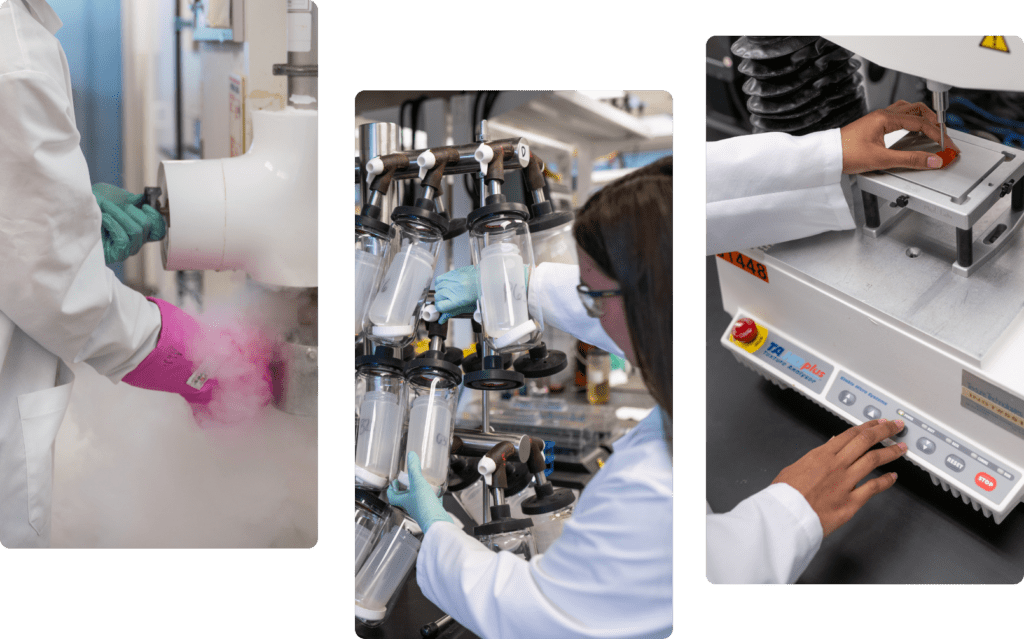Fiber (CODEX Definition) - Total, Soluble, Insoluble Test
- Price
$585 per analysis
- Turnaround time
7 – 9 Business Days
- Rush
Available


Technical data sheet
- Method description
Samples (defatted if necessary) are digested with a mammalian alpha-amylase and an amyloglucosidase for 16 hours at 37oC to simulate the human digestive system. Following digestion, the sample is heated to 95oC to denature all enzymes and proteins present and then digested at 60oC with protease. Insoluble digestion resistant material (dietary fiber) is filtered away and the amount of Insoluble Dietary Fiber (IDF) is determined gravimetrically with protein and ash content subtracted (note: protein and ash are determined on the residue). The dietary fiber remaining in solution following the filtration is precipitated with ethanol and is collected in a second filtration step. The amount of dietary fiber collected in the filter is determined gravimetrically with protein and ash subtracted as above and is recorded as the Gravimetric Soluble Dietary Fiber (G-SDF). The filtrate containing the soluble dietary fiber not precipitated by the ethanol is concentrated and analyzed by High Performance Liquid Chromatography (HPLC) to determine the total HPLC-Soluble Dietary Fiber (HPLC-SDF) with a degree of polymerization (DP) greater than or equal to 3 (DP3). The total Soluble Dietary Fiber is calculated as the sum of the Gravimetric-Soluble Dietary Fiber and the HPLC-Soluble Dietary Fiber (SDF = G-SDF + HPLC-SDF). Total dietary fiber is calculated as the sum of the Insoluble Dietary Fiber and the Soluble Dietary Fiber (TDF = IDF + SDF).
- Acceptable matrices
Food and Food Ingredients
- Unacceptable matrices
Baking powder, Samples containing more than 2% stevia
- Limit of quantitation
Total Dietary Fiber - 0.1% Insoluble Dietary Fiber – 0.1% Soluble Dietary Fiber-0.1%
- Equipment
General Gravimetric Analytical Chemistry Equipment HPLC-Refractive Index Detector
- Method reference
AOAC 2011.25
- Reportable unit
%
- Sample size requirements
25 g
- Information required by submitter
please supply expected estimates. Indicate matrix type, and indicate if samples are high in fat (>5% fat). Indicate whether the sample contains stevia, fructans (inulin or fructooligosaccharides (FOS)), psyllium, flax, and gum (i.e. guar gum)
- Additional information
Please include notification for samples containing DP2 and DP3 carbohydrates (Isomalto-oligosaccharides (IMO), Maltiltol, Lactose). Measures total dietary fiber including resistant starch and non-digestible oligosaccharides of DP >3. Dietary Fiber is the portion of the carbohydrates which is not digested in the human gut. It is composed of both soluble and insoluble components. These methods are applicable to all food products; however samples containing psyllium or fructans should be submitted under specific test codes. High-fat (>5%) samples require special handling.
Is this the most suitable fiber test for evaluating my product?
Find your fiber source(s) on the chart and use the alpha reference to see how it aligns with each method. If the alpha reference is fully inside the method circle, that method is optimal for your fiber source(s). If it's outside or touching the circle's edge, the method won't fully capture the fiber. Remember to check applicable labeling regulations for allowed fiber sources.
- AOAC Method 2001.03
AOAC Method 991.43 - AOAC Method 2017.16
AOAC Method 2022.01 - AOAC Method 985.29
AOAC Method 991.43 - AOAC Method 2009.01
AOAC Method 2011.25
-
Cellulose | Beta-Glucan | Psyllium | Gums | Lignin
-
Galacto-oligosaccharides-Raffinose(GOS)/Stachyose
-
Galactomannan | Arabinoxylan | Glucomannan
-
Resistant Starch RS4
-
Resistant Starch RS2 & RS3
-
Pectin | Alginates | Arabinogalactin | Isomalto-oligosaccharide (IMO)
-
Polydextrose | Fibersol®-2 | Resistant Maltodextrins | Soluble Corn Fiber (SCF)
-
Fructans (Inulin, FOS)
-
Cellulose | Beta-Glucan | Psyllium | Gums | Lignin
-
Galacto-oligosaccharides-Raffinose(GOS)/Stachyose
-
Galactomannan | Arabinoxylan | Glucomannan
-
Resistant Starch RS4
-
Resistant Starch RS2 & RS3
-
Pectin | Alginates | Arabinogalactin | Isomalto-oligosaccharide (IMO)
-
Polydextrose | Fibersol®-2 | Resistant Maltodextrins | Soluble Corn Fiber (SCF)
-
Fructans (Inulin, FOS)
-
Cellulose | Beta-Glucan | Psyllium | Gums | Lignin
-
Galacto-oligosaccharides-Raffinose(GOS)/Stachyose
-
Galactomannan | Arabinoxylan | Glucomannan
-
Resistant Starch RS4
-
Resistant Starch RS2 & RS3
-
Pectin | Alginates | Arabinogalactin | Isomalto-oligosaccharide (IMO)
-
Polydextrose | Fibersol®-2 | Resistant Maltodextrins | Soluble Corn Fiber (SCF)
-
Fructans (Inulin, FOS)
-
Cellulose | Beta-Glucan | Psyllium | Gums | Lignin
-
Galacto-oligosaccharides-Raffinose(GOS)/Stachyose
-
Galactomannan | Arabinoxylan | Glucomannan
-
Resistant Starch RS4
-
Resistant Starch RS2 & RS3
-
Pectin | Alginates | Arabinogalactin | Isomalto-oligosaccharide (IMO)
-
Polydextrose | Fibersol®-2 | Resistant Maltodextrins | Soluble Corn Fiber (SCF)
-
Fructans (Inulin, FOS)
Common Fiber (CODEX Definition) - Total, Soluble, Insoluble Test Testing Questions
We make every effort to keep our methods and detection limits up to date according to the latest standards and qualifications. If you have any questions regarding the limit of detection/quantification or method references, please contact our Customer Service team at 1-800-245-5615.
Our standard turnaround time is 10 business days for most assays. There are some assays that require a longer turnaround time. We also offer a RUSH service that is half the time of the standard turnaround time of the assay at double the cost of the assay. A few assays that we provide cannot be rushed due to the nature of the test. Please check the specific assay you are interested in regarding the ability to RUSH the turnaround time.
Sample prep and processing are critical to any analytical test to ensure the highest accuracy.
Some fiber ingredients are not very sensitive to processing, apart from the general prep dictated by the published method. Other fiber ingredients, such as RS4, are much more sensitive to sample processing than others and may require additional information for Medallion to run testing in the best way. To ensure the most accurate results for fiber testing, please carefully read and select the appropriate prompts that appear on the online submission form and we’ll take care of the rest.
Lower LOQ/LOD for our Dietary Fiber tests are 0.1% w/w, i.e., 0.1g Fiber per 100g sample.
We take the quality and accuracy of our results seriously. In the lab, one part of our quality system is to have carefully controlled samples that we run with each testing batch. These samples have known and set limits for fiber content that is monitored with every round of testing. Other equipment is routinely calibrated and examined before and during testing, and equipment is maintained and cleaned on a regular basis.
Besides equipment, our scientists are thoroughly trained on the methods and must pass proficiency testing, training, and competency in a method before allowing testing to be conducted.
Outside of the specific lab team, Medallion is ISO/A2LA Accredited across many of our testing, including several dietary fiber tests.
There are several factors that need to be considered when choosing the ‘best’ fiber method for your product. Regulations and the source of dietary fiber tend to be the top reasons for choosing a method. Many of the newer fiber methods are better able to capture fiber ingredients that are missed in traditional fiber tests, such as polydextrose or fructans/inulin. However, the newer methods tend to have more complex procedures and have a higher cost.
We have a blog post that goes over selecting the best fiber method for your sample, and as always, you can reach out to Customer Service if you need help.
Dietary Fiber methods tend to be very robust and allow for a very wide range of sample types to be tested. However, there are several ingredients that need extra attention for Medallion to accurately test them. Some examples include: Stevia, High Fat Content, RS4 Fiber, and Psyllium. We have prompts on our online submission form to help ensure that we have everything set up correctly, and it is very important to read and select the prompts that apply to your product.
Our food testing experts are here to help.
"*" indicates required fields

Helpful content related to Fiber (CODEX Definition) - Total, Soluble, Insoluble Test
Submit your order online and ship your samples today. If you have questions, we are always here to help.
A food testing program designed with mid-market and enterprise food and ingredient manufacturers in mind.
